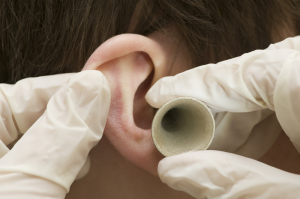Introduction
Ear problems and parotid gland problems are part of the ear/nose/throat chapter of the nethealthbook.
As already mentioned in the introduction to the ear/nose/throat chapter a blocked eustachian tube does not allow ventilation of the middle ear through the eustachian tube, which is crucial for the health of the middle ear. A picture of the complex anatomy regarding the middle ear and the eustachian tube can be seen through this link.
This site shows that at the end of the ear canal is the eardrum, which separates the middle ear from the outer ear as long as the eardrum is intact. From the middle ear the eustachian tube connects to the back of the throat. This connection is important as the pressure inside the middle ear is equalized through this mechanism and the fact that with every yawning, swallowing or laughing the eustachian tube opens for a split second. This is enough to equalize the pressure.
Pathological conditions can disturb the ventilation mechanism of the eustachian tubes
With pathological conditions such as viral illnesses, allergies, scarring from previous infections of the eustachian tubes (adhesions) the ventilation mechanism is disturbed. This eustachian tube dysfunction leads to a vulnerability for further recurrent infections of the middle ear. Enlarged adenoids that are close to the entrance of the eustachian tube in the back of the throat can also cause a lack of ventilation.
Diseases of the salivary glands
You may find it strange that I would deal with diseases of the parotid glands in a chapter of ear diseases. As complications with these diseases are dealt with by ENT specialists, it felt quite logical that it would be placed in one of these 3 ENT chapters. Here is an overview:
The parotid gland provides the bulk of our saliva along with the submandibular glands. A common childhood disease is mumps, which is a viral infection.
Parotid gland tumor
Inside of the parotid gland a parotid gland tumor can develop.
As the parotid gland and the temporomandibular joint (TMJ) are situated close together, sometimes TMJ symptoms may be mistakenly thought of as parotid gland pain when in actuality it is referred pain from the temporomandibular joint.
The parotid gland has a system of ducts through which saliva is transported into the oral cavity. Inside of these ducts stones can form, which then will cause pain and swelling in the affected parotid gland (salivary gland stones).
References
1. The Merck Manual, 7th edition, by M. H. Beers et al., Whitehouse Station, N.J., 1999. Chapter 84.
2. Noble: Textbook of Primary Care Medicine, 3rd ed.,2001, Mosby Inc.
3. The Merck Manual: Middle and Inner Ear Problems
4. Rakel: Conn’s Current Therapy 2001, 53rd ed.,2001, W. B. Saunders Company
5. Goldman: Cecil Textbook of Medicine, 21st ed.,2000, W. B. Saunders Company
6. Mandell: Principles and Practice of Infectious Diseases, 5th ed.,2000, Churchill Livingstone, Inc.
7. The Merck Manual, 7th edition, by M. H. Beers et al., Whitehouse Station, N.J., 1999. Chapter 265.
8. MF Williams: Otolaryngol Clin North Am; Oct1999; 32(5): 819-834.
9. The Merck Manual, 7th edition, by M. H. Beers et al., Whitehouse Station, N.J., 1999. Chapter 106.
10. Ferri: Ferri’s Clinical Advisor: Instant Diagnosis and Treatment, 2004 ed., Copyright © 2004 Mosby, Inc.
11. Rakel: Conn’s Current Therapy 2004, 56th ed., Copyright © 2004 Elsevier







